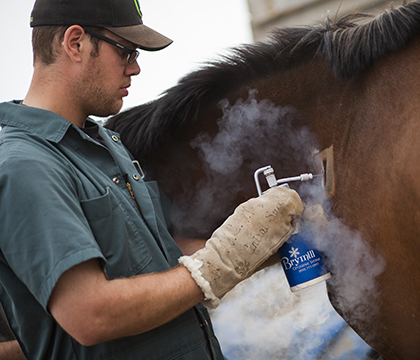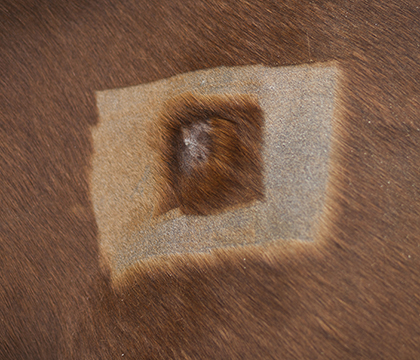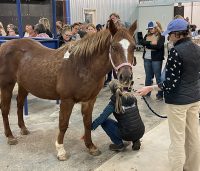Equine sarcoids: a mystery gone viral

Using liquid nitrogen (cryotherapy) to freeze off an equine sarcoid is one way to treat the recurring skin tumours, but WCVM scientists eventually hope to find a more effective therapy option. Photos: Christina Weese.
Not all detectives wear fancy hats and trench coats with a magnifying glass tucked in the pocket. Some of them wear white lab coats and use powerful microscopes.
“My dad’s a pathologist, so there you go. It’s the family business,” says Dr. Bruce Wobeser, associate professor of veterinary pathology at the Western College of Veterinary Medicine (WCVM). “What’s appealing to me about pathology is that it’s essentially detective work.”
Veterinary pathologists like Wobeser study body fluids and tissues in the same way that detectives investigate crime scenes: they both look for clues. But instead of answering queries about guns and other murder weapons, veterinary pathologists are searching for answers to more atypical questions.
For example, where do equine sarcoids come from?
Wobeser and other researchers know that sarcoids — the most common skin tumour in horses — are caused by bovine papillomavirus (BPV). But what remains a mystery is how a bovine-specific papillomavirus is responsible for causing skin tumours in horses.
“Most papillomaviruses are species-specific, so horses get horse papillomavirus [and] people get humanpapillomaviruses,” says Wobeser. “The exception to that seems to be the papillomaviruses that cause sarcoids.”
Wobeser started studying sarcoids in 2006 as the subject of his PhD thesis, with the support of the Townsend Equine Health Research Fund (TEHRF). His graduate supervisor was Dr. Andrew Allen who is also a veterinary pathologist at the WCVM. At the time, there was no definitive test for identifying sarcoids and there still isn’t, despite Wobeser’s interest in finding one and the fact that equine sarcoids are so common. After Wobeser joined the WCVM faculty in 2010, he continued to investigate equine skin diseases — and now works alongside a graduate student of his own.
The trouble with sarcoids is that it can be difficult to pick them out of a line up of other suspects. On the surface, they look like proud flesh (exuberant granulation tissue, an excessive healing response in horses), and even on a slide it can be difficult to tell the difference between them.
Sarcoids are also unpredictable. Sometimes they just go away on their own. Sometimes they respond to biopsies and treatment attempts with the anger of self-righteous thugs, becoming more aggressive.
Sarcoids range in appearance from a hairless patch of skin to smooth nodules to fleshy, ulcerated masses, and they can seriously impair a horse depending on their location. Treating sarcoids is complicated, and there are a lot of unsolved mysteries in their case file.
“If you don’t have a good understanding of what’s causing the disease that’s in front of you, then as a veterinarian in general practice you don’t have a good idea about what to do about it,” says PhD student Dr. Sarah Greenwood, who works alongside Wobeser.
Treatments for sarcoids include surgical removal, but the rate of recurrence is high. Other options include chemotherapy and radiation treatments. Other scientists have attempted to develop a vaccine against sarcoids, but so far, those efforts are still unsuccessful.
Back in 2009, Wobeser and Allen examined 800 sarcoid biopsies, and discovered that 80 per cent of sarcoid cases In Western Canada are caused by a strain of the BPV virus known as BPV-2. Other places in North America and around the world see a predominance of sarcoids caused by BPV-1.
However, not all horses infected with BPV develop sarcoids, and BPV is often found in the normal skin and non-sarcoid skin lesions in horses. This means that the presence of BPV doesn’t guarantee sarcoid growth.

A close up of an equine sarcoid.
“If we can figure out why the papillomavirus causes the tumours, then maybe we can prevent them,” says Wobeser. “In people, human cervical cancer is caused by a papillomavirus. Vaccines exist now, but it took decades of research to demonstrate that cervical cancer is linked to this papillomavirus, and we’re not there yet with horses. We don’t have the money to do it. You know, it’s a horse thing — not a human health thing.”
Since he completed his PhD work in 2010, Wobeser has participated in a series of research projects that probe the issue of equine skin cancer. Wobeser’s sarcoid sleuthing has dragged papillomavirus into the hot seat and opened a new line of questioning — specifically a new research project where Wobeser, Greenwood and a team of researchers will investigate the role of an equine papillomavirus (EcPV) in the development of equine squamous cell carcinomas. This research project, funded by TEHRF, is the subject of Greenwood’s PhD thesis.
Other members of Wobeser’s detective team are Dr. Dale Godson, a diagnostic microbiologist at Prairie Diagnostic Services (PDS) and an immunohistochemistry (IHC) specialist, and Dr. Tasha Epp, an associate professor of zoonosis at the WCVM.
“The work that we’re doing right now is so early that it’s very broad. We’re asking very simple questions,” says Greenwood. “We want to know how prevalent the virus is, and how many horses are exposed. Is it interacting with specific cancer-causing proteins in the cells? If we can get some of those answers down, hopefully future research can get closer and closer.”
“What we want to know is are they [papillomaviruses] making cells replicate faster? Are they preventing cells from dying their normal death?”
The WCVM-based work on papillomaviruses in horses started more than a decade ago with Wobeser’s sarcoid inspection. Greenwood says those efforts laid the groundwork for the techniques and the types of studies that their research team is now using to profile EcPV-2. Their long-term goal is to improve the prognosis, therapy and prevention of squamous cell carcinomas and other equine skin cancers.
Squamous cell carcinomas and sarcoids are both skin tumours caused by a papillomavirus. But unlike sarcoids, squamous cell carcinomas are often fatal. They’re also caused by a strand of equine papillomavirus known as EcPV-2.
Like BPV, researchers know very little about when and how EcPV is transmitted between horses, and even less is known about how this particular virus causes cancer. Researchers have identified seven distinct types of EcPV so far and only one of those (EcPV-2) is linked to cancer — but it’s highly probable that more EcPV types are hiding out in the skin of horses.
In a project made possible with funding from TEHRF, Wobeser and his research team intend to find out.
“If thousands of horses are infected with the papillomavirus, only a small proportion will develop tumours from that,” says Wobeser. “Being infected doesn’t give you the disease. It doesn’t cause the tumours necessarily, so there has to be something else.”
One potential idea is that the virus reacts to, or takes advantage of, something found in the small percentage of horses that develop these tumours.
Papillomaviruses infect the basal layers of your skin. As skin cells mature, they change and then eventually get to the top and fall off. Papillomaviruses depend on that maturation of the skin cells to complete their cycle. They go through different replicative stages as they get closer to the surface, and then when the top layer of skin sheds off, mature viruses are shed as well.
“What we want to know is are they [papillomaviruses] making cells replicate faster? Are they preventing cells from dying their normal death?” says Wobeser.
Wobeser and Greenwood are also investigating differences between tumours associated with the papillomavirus and tumours that aren’t linked to the virus. Understanding these differences could be the key to pinpointing the role that papillomaviruses play in tumour development.
“In people if you have a papillomavirus-positive tumour, the prognosis is better than if you have a papillomavirus-negative tumour,” says Wobeser. “They respond better to treatment. They tend to be less aggressive and they spread less quickly. We want to know if that’s true in horses as well.”
In the cases of tumours where the influence of a papillomavirus appears to be absent, Greenwood says that doesn’t necessarily mean the cancer was virus-free.
“One of the theories for a long time was that it’s possible the virus comes in, does its damage, the body clears the virus but the cells are going now,” says Greenwood. “In those cases it was caused by a virus but you can’t find it.”
This theory — the idea that a virus might sneak in when nobody’s watching and then slip away without any obvious trace — is called a “hit and run.”
Like all good detectives, pathologists have to ask a lot of questions. Research begets more research and answers are not always easily found But that’s one of the things that Wobeser likes best about his work.
“Every case is different. That appeals to me.”
Kyrsten Stringer of Wolseley, Sask., is a Master of Journalism student at the University of Regina. She was a communications intern at the WCVM during the summer of 2017.


Comments